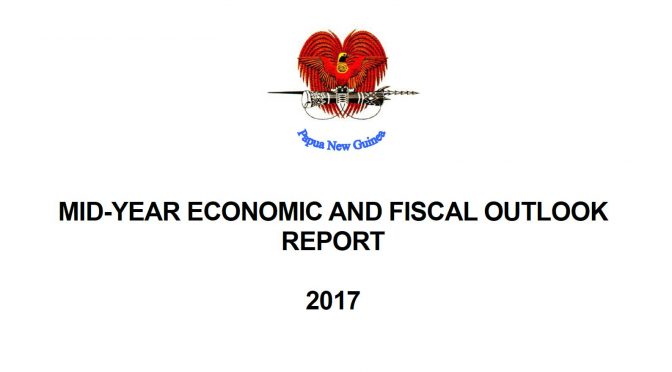The PNG Treasury released the 2017 Mid Year Economic and Fiscal Outlook (MYEFO) last night (31 July)- see here.
This is an extraordinary document . Amongst the detail is a damning insight into O’Neill’s continuing mismanagement of the budget. There is little doubt that the original 2017 budget was fiscally fraudulent (see here and here).
The PNG Treasury document indicates, in summary:
- The budget deficit is over K1 billion larger than forecast only 7 months ago. The PNG Treasury document states the deficit has increased from K1,9bn to K2.8bn.
- This will continue the pattern of the O’Neill government having consistently the largest budget deficits of any government in PNG’s history – see here.
- And the actual deficit forecast is actually over K3bn when including the blowout in interest costs for all the public debt from K1.3bn to K1.5bn. This is the 3rd highest item of government expenditure – a fact hidden by O’Neill when describing the budget during the election campaign (see here).
- Interest costs have jumped because public debt has exploded from an estimate of 2017 debt of K21,623m to K25,939.4m.
- An extra K4,316.1m in debt – all within the 2017 forecast.
- Any head of a household would be sacked for getting the figures so wrong – the fall in commodity prices occurred back in 2014/15 – why are the 2017 figures so wrong?
- The debt to GDP ratio for 2017 blows out from 29% to 34.5%.
In the words of the PNG Treasury (p 30 of the PNG Treasury document), “One measure of debt sustainability is the debt to GDP ratio. According to the FRA [Fiscal Responsibility Act], the debt ratio limit is 30.0 per cent of GDP. The updated MYEFO estimate is projected to be 34.9 per cent of GDP, which is 4.9 percentage points above the legislated limit.”
Major expenditure cuts are foreshadowed in a Supplementary Budget – “In the likely event that revenue falls, a reduction in expenditure through a Supplementary Budget is required of the Government to keep debt within legal limits and consistent with the MTDS [Medium-Term Debt Strategy]” p30.
Some of O’Neill’s promises during the election campaign are extraordinarily expensive, and these would make the outcomes even worse.
In an extremely worrying comment, with no details provided, the PNG Treasury states “Also captured in the Total Public Debt Stock Outstanding are the State-guaranteed loans now being serviced by the State.” (p29).
As the deficit is some K1.1bn higher, and the total increase in public debt is K4.3bn higher, the difference of K3.2bn is probably the costs of the Oil Search share purchase debacle. These costs are now being carried by all PNG taxpayers and not Kumul. That was a shocking deal for the people of PNG -and its legality has still not been tested in the courts (although one Treasurer was sacked over the issue).
The growth forecast falls slightly – it is now indicating on per capita terms, the PNG economy will go backwards by 0.4% in 2017. For too long, PNG’s economic performance has gone backwards – see here and here.
Conclusion
Overall, this is an extraordinarily frank document. My credit to the brave PNG Treasury authors. Still, it is written by professional public servants, so the punches have been pulled.
But between the lines, the only conclusion is one of extraordinary economic mismanagement.
It is a shame there was not more time for new members of Parliament to reflect on the document before the scheduled vote on PNG’s new Prime Minister – especially given the nature of a “closed” camp. The 2017 budget was indeed fraudulent.
O’Neill has a track record that gives him an “E” for economic management. That is a sad legacy for PNG’s future generations.
Hopefully, a new government can start the process of economic repair.

